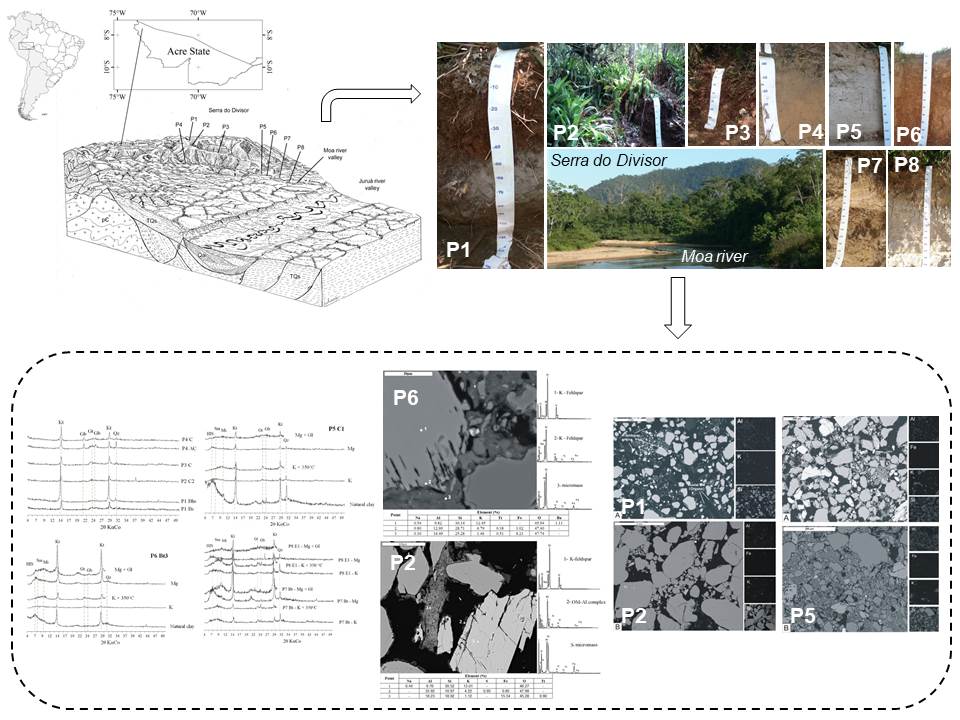Genesis and micropedology of soils at Serra do Divisor and Moa river floodplain, northwestern Acre, Brazilian Amazonia
28/Aug/2020
ABSTRACT The northwestern part of the Acre State (Brazil) possesses singular soils in Brazilian Amazonia, but have been very little studied. This study aimed to discuss the genesis and some micropedological aspects of the soils from Serra do Divisor and adjacent floodplain soils of the Moa river, to enhance the knowledge on their formation. A toposequence of soils ranging from the uppermost part of sub-Andean Serra do Divisor to the Alluvial soils of Moa river floodplain was studied, regarding chemical, […]
Spatial Variability of Soil Properties in Archeological Dark Earth Sites under Cacao Cultivation
01/Aug/2016
ABSTRACT Soils with an A horizon formed by human activity, an anthropogenic A horizon, are found in the Amazon Region. Few studies have examined the spatial distribution of the properties of these soils. We mapped the spatial variability of some soil properties in an area of Archaeological Dark Earth (ADE) in the Brazilian Amazon. A sampling grid was defined over an area of 42 × 88 m under cacao cultivation in which sampling points were established at a spacing of […]
Characterization and classification of gleysoils on the floodplain of the Solimões river (Iranduba and Manacapuru), Amazonas, Brazil
01/Apr/2013
The floodplains of the Solimões River are areas periodically flooded with predominance of Gleisols,where have lived a large number of small farmers of the region. The purpose of this study was to characterize and classify five profiles of Gleysoils distributed in three floodplain areas of the Middle Amazon basin, located in the municipalities of Manacapuru and Iranduba. After the morphological description, the soil horizons were sampled to perform physical, chemical and mineralogical analyses. Similarly, significant gleization was observed in all […]
Genesis, chemistry and mineralogy of soils derived from Plio-Pleistocene sediments and from volcanic rocks in Roraima North Amazonia
01/Apr/2011
The influence of parent material, varying from Plio-Pleistocene sediments and basic volcanics, and topographic position, to soil genesis, was studied in a topolitossequence typical of savanna at the Cauamé River catchment, Roraima. We aimed to describe the soil variability under savanna by means of chemical, physical and mineralogical attributes. Fourteen soil profiles were described and samples, allowing the identification of the following classes: Yellow Latosol, Red Latosol, Yellow and Red-Yellow Argisols, Plinthosols, Gleisols, Fluvic Neosols and Vertisols. The mineralogy was […]
Phosphorous forms in cultivated indian black earth (anthrosols) of varying texture in the brazilian Amazon
01/Oct/2009
Despite the agricultural importance of Indian Black Earth (IBE) in the Amazon region, there are few studies that report on the relation between soil texture and chemical fertility of IBE. These soils of pre-Colombian origin, with high contents of P, Ca and other nutrients are found across the Amazon valley. IBE profiles were studied to evaluate the total contents of P, its primary chemical forms and the P transformation phases in areas with IBE soils of variable texture and in […]
Physical chemical and mineralogical characteristics of soils from the agricultural colony of Apiaú ( Roraima, Amazonia), under different land uses and after burning
01/Dec/2006
There are few studies on soils under slash-and-burn agriculture in settlements in Amazônia. The aim of this study was the soil characterization in the Apiaú Agricultural Colony, Roraima, and to evaluate changes in some soil chemical properties in function of the management systems and the impacts of burning to the soil properties. The studied areas were: pastures, cultivated with banana and maize, burned forest and natural forest. The samples were submitted to physical chemical and mineralogical analysis. The soils are […]

